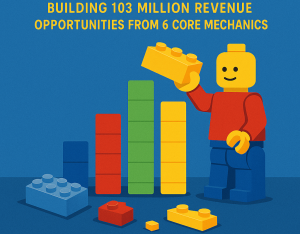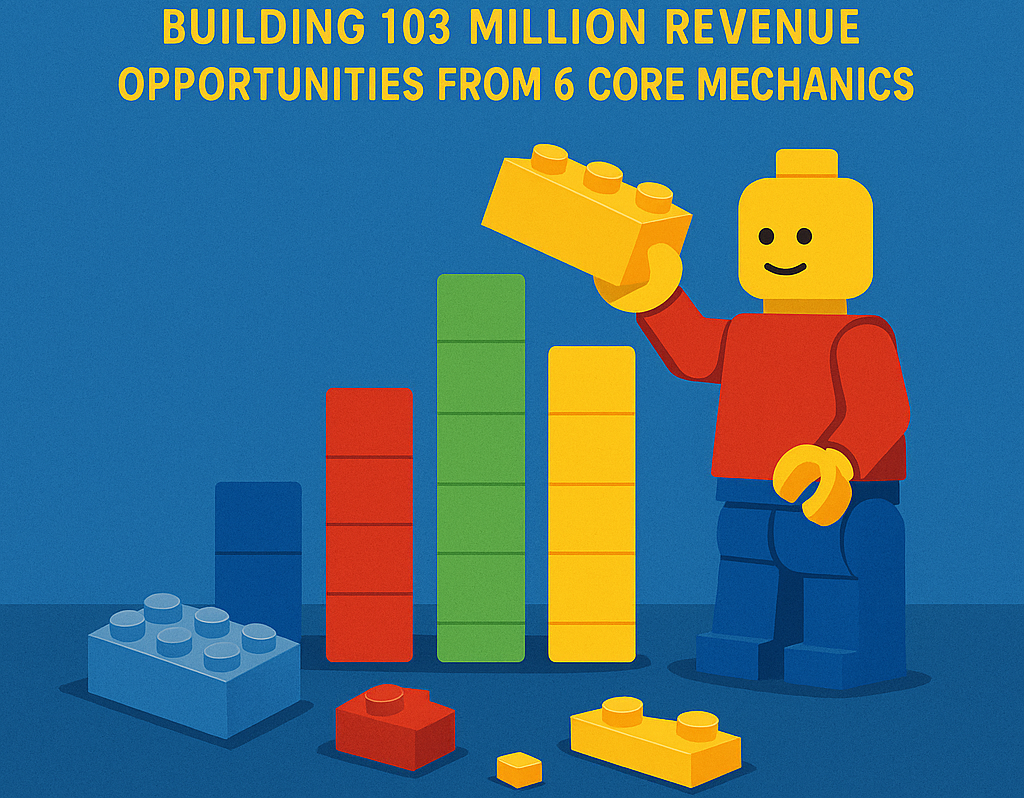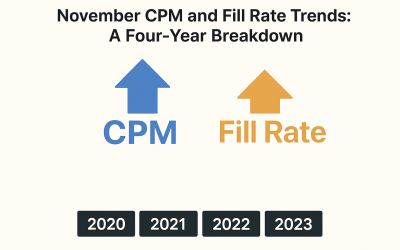The LEGO Principle: Building 103 Million Revenue Opportunities from 6 Core Mechanics
Here is a quick Monday read from AppLixir Team! In 1958, LEGO made a remarkable discovery that would change the way we think about creative play forever. Their researchers calculated that just six standard 2×4 LEGO bricks could be combined in 915,103,765 different ways. While that exact number has been debated over the years, the principle remains profound: a small set of standardized, well-designed components can generate virtually unlimited possibilities.
This isn’t just a fun fact for toy enthusiasts. It’s a fundamental design principle that applies directly to one of the most challenging aspects of modern game development: monetization.
Contents
- 1 The Universal Connector Problem
- 2 Your Six Standard Bricks
- 3 The Power of Strategic Combinations
- 4 Why Standardization Wins
- 5 The Architecture of Player Choice
- 6 Building Without Collapse
- 7 Case Study: The Balanced Build
- 8 The Mathematics of Monetization
- 9 Building Your Strategy
- 10 The Future of Modular Monetization
- 11 Your Six Bricks Are Waiting
The Universal Connector Problem
When LEGO patented their brick design in 1958, they weren’t just creating a toy. They were solving a universal problem: how do you create a system that’s simple enough for anyone to use, yet complex enough to remain engaging indefinitely?
Game monetization faces the exact same challenge. Developers need systems that are easy for players to understand, don’t disrupt gameplay, and can generate sustainable revenue across diverse player segments. Try to build too many custom monetization mechanics, and you’ll confuse players while drowning in implementation complexity. Build too few, and you’ll leave revenue on the table or exhaust your monetization options too quickly. The answer, like LEGO discovered, lies in modular design.
Your Six Standard Bricks
Before we explore combinations, let’s identify the “standard bricks” of modern game monetization. While there are dozens of tactics, most successful free-to-play ga mes build their economies around six core mechanics:
mes build their economies around six core mechanics:
- Rewarded Video Ads – The universal connector that lets players exchange attention for in-game value
- In-App Purchases (IAPs) – Direct currency, item, or content purchases
- Battle Passes/Season Passes – Time-gated progression systems with free and premium tracks
- Cosmetics/Customization – Appearance-based items with zero gameplay impact
- Gacha/Loot Systems – Randomized reward mechanisms that create collection psychology
- Subscriptions – Recurring payments for ongoing benefits
Just like LEGO bricks, each of these mechanics is valuable on its own. But the real magic happens when you start combining them strategically.
The Power of Strategic Combinations
Following on The LEGO Principle post, consider rewarded video ads, arguably the most versatile “brick” in mobile gaming. On its surface, it’s simple: player watches a 15-30 second advertisement, receives an in-game reward. But look at how this single mechanic transforms when combined with your other pieces:
- Progression Systems + Rewarded Video creates boost mechanics. Players can watch an ad to double their XP earnings, speed up a timer, or get an extra life. Games like Subway Surfers have generated hundreds of millions in ad revenue with this simple combination.
- Gacha Systems + Rewarded Video offers extra pulls or improved odds. Instead of forcing players to pay for another spin, you give them the option to watch an ad. This combination respects player agency while monetizing the psychological pull of “just one more try.”
- Social Features + Rewarded Video enables gifting without depleting personal resources. Players can send energy or items to friends by watching ads, creating positive social interactions that cost the sender nothing but time.
- Battle Pass + Rewarded Video provides progression shortcuts. Miss a day? Watch a few ads to catch up on daily challenges. This combination reduces player anxiety about falling behind while generating revenue from engaged players who don’t want to pay directly.
Each combination creates a different value proposition, appeals to different player motivations, and activates at different moments in the player journey. This is your 103 million combinations at work.
Why Standardization Wins
LEGO’s breakthrough wasn’t just the brick itself—it was the standardization. Every brick used the same coupling system, the same dimensions, the same quality standards. This meant that bricks from different sets, different years, even different decades could work together seamlessly. Rewarded video ads became the dominant monetization mechanic for the same reason. When ad networks, mediation platforms, and game developers all agreed on standard formats (15-30 second videos, reward-on-completion, opt-in experiences), they created a universal system that works across virtually any game genre.
This standardization created predictable economics. Developers know that rewarded video typically generates eCPMs (effective cost per thousand impressions) between $10-$60 depending on geography and game genre. They know fill rates hover around 85-95% with proper mediation. They can model revenue with confidence. Compare this to custom monetization mechanics. Every proprietary system requires player education, A/B testing, risk analysis, and often creates confusion. Like proprietary toy building systems that died in LEGO’s shadow, overly complex or unique monetization often fails not because the idea is bad, but because it lacks the universal understanding that standardized systems provide.
The Architecture of Player Choice
Here’s where game monetization can learn LEGO’s most important lesson: the system works because it empowers choice, not because it forces outcomes. Nobody tells a child exactly how to build with LEGO. The joy comes from infinite possibility within a structured system. Similarly, the most successful monetization strategies let players choose when, where, and why they engage with revenue mechanics.
This is why rewarded video ads consistently outperform forced interstitial ads by 3-5x in terms of player retention. When players opt in to watch an ad because they want the reward, they maintain agency. They’re making a conscious trade: their attention for tangible value. Studies have shown that 52-68% of players will engage with rewarded video ads when offered at appropriate moments, compared to the universally negative sentiment toward forced interruptions.
The same principle applies to IAPs. Games that offer multiple purchase tiers, frequent sales, and various bundle options give players choices that match their budget and commitment level. A player might ignore a $99.99 premium currency pack but happily buy a $4.99 starter bundle that feels like excellent value. Battle passes exemplify choice architecture perfectly. Players can engage with the free track, experiencing the progression system without payment. When they’re invested, the premium pass becomes an attractive upgrade. And for the most engaged players, tier skips and premium cosmetics offer additional spending opportunities. One system, multiple entry points, respect for player decision-making.
 Building Without Collapse
Building Without Collapse
LEGO structures have a limit. Stack bricks carelessly, and your tower falls. Create an unbalanced design, and it won’t hold together. The same physics applies to monetization—push too hard, combine too aggressively, and your player economy collapses.
This is where many games fail. They identify that rewarded videos + gacha + battle passes all generate revenue independently, so they implement all three at maximum intensity. Players suddenly face:
- Constant prompts to watch ads for every conceivable reward
- Aggressive gacha systems with poor odds and expensive pulls
- Battle passes that require unrealistic time investment or large purchases to complete
- Daily login rewards, limited-time events, flash sales, and a dozen other retention mechanics all firing simultaneously
The result? Player exhaustion. The experience feels exploitative rather than rewarding. Churn spikes. Negative reviews accumulate. The beautiful possibility of 103 million combinations collapses into aggressive monetization that drives players away.
The solution is what I call “breathing room design.” Your monetization mechanics should have space between them. Rewarded videos should appear at natural pause points—after completing a level, when making a strategic choice, or when a player has exhausted their resources. Not every five minutes. Not as a pop-up interrupting core gameplay. Your gacha system should feel like an exciting bonus, not a mandatory grind. Your battle pass should be completable by engaged players who don’t spend, with purchases offering convenience rather than being absolutely necessary.
Think of it like LEGO’s spacing. The studs on top of bricks aren’t placed randomly—they’re precisely positioned to create strong connections without making bricks impossible to separate. Your monetization needs the same thoughtful spacing.
Case Study: The Balanced Build
Contiuning on The LEGO Principle: Building 103 Million Revenue Opportunities from 6 Core Mechanics post, consider “Stumble Guys,” a mobile game that has generated over $300 million in revenue. Their monetization architecture combines five of our six standard bricks:
They use rewarded videos for extra lives and currency boosts—but they limit how many you can watch per session, preventing player fatigue. Their battle pass offers cosmetic rewards on free and premium tracks, with reasonable progression that doesn’t demand grinding. They sell cosmetic items directly for players who want specific looks without randomness. They offer a limited gacha system for special items, but it’s not the primary acquisition method. And they have a VIP subscription that provides ongoing benefits without creating pay-to-win scenarios.
No single mechanic dominates. Each supports the others. Players can engage with the monetization they prefer—direct purchases for some, ads for others, battle pass for the committed, gacha for collectors. The combinations create multiple revenue streams from different player segments without any one system feeling exploitative.
The Mathematics of Monetization
Let’s return to that 103 million number. Obviously, not every combination of six LEGO bricks creates something useful. Many combinations are functionally identical, just rotated. Others create unstable structures. The same applies to monetization combinations.
But here’s the key insight: you don’t need 103 million revenue strategies. You need to find the 10-20 meaningful combinations that work for your specific game, genre, and audience. A puzzle game might combine rewarded videos with cosmetic customization and a casual battle pass. A strategy game might emphasize direct IAPs, subscriptions, and time-skip mechanics. A collector-focused RPG might lean heavily on gacha systems supported by currency-earning rewarded videos and battle passes that reward daily engagement.
The point isn’t to implement every possible combination. It’s to recognize that your monetization toolkit has exponentially more potential than you might assume. Those six standard mechanics can create dozens of meaningful revenue opportunities if you’re willing to experiment with how they connect.
Building Your Strategy
So how do you apply the LEGO Principle to your game’s monetization? Start by auditing your current mechanics. Which of the six standard bricks are you using? More importantly, which combinations have you explored? Many games implement rewarded videos but only use them for currency rewards. They’re missing the combinations with progression boosts, gacha pulls, social gifting, and battle pass acceleration.
Next, map your combinations to player motivations. Different players engage with games for different reasons—achievement, social connection, collection, competition, creativity. Each monetization combination appeals to different motivations. Rewarded videos for progression appeal to achievement-focused players. Cosmetic purchases appeal to creative players. Gacha appeals to collectors. Make sure your combinations cover your player spectrum.
Finally, test your load-bearing walls. Where is your monetization too aggressive? Where do players disengage? Use your analytics to find the breaking points, then pull back. Remember, LEGO builds need balance. So does your economy.
The Future of Modular Monetization
The LEGO has spent 67 years since that 1958 discovery refining their system. They’ve added new brick types, new themes, new technologies like their video game franchises. But the core principle remains: standardized components, infinite combinations, respect for builder creativity. Game monetization is following a similar evolution. We’re seeing new mechanics emerge—Web3 integrations, direct creator monetization, user-generated content marketplaces. But the successful implementations will be those that act like new brick types: compatible with existing systems, easy to understand, and expanding possibilities rather than replacing what works.
Games that will thrive in the next decade won’t be those with the most aggressive monetization. They’ll be the ones that recognize the combinatorial power of a few well-designed, player-respecting mechanics. They’ll build monetization architectures with the elegance of a LEGO set—simple components creating complex, beautiful, sustainable structures.
Your Six Bricks Are Waiting
Before I finalize the The LEGO Principle: Building 103 Million Revenue Opportunities from 6 Core Mechanics post, the LEGO’s discovery was profound because it revealed that limitation breeds creativity. You don’t need infinite pieces. You need the right pieces and the wisdom to combine them well. Your game already has access to proven monetization mechanics. The question isn’t whether you should invent new bricks. It’s whether you’re exploring the 103 million ways to combine the ones you already have.
So what combinations are you leaving on the table? What revenue opportunities exist in the spaces between your current systems? The bricks are standardized. The possibilities are infinite. Start building.



